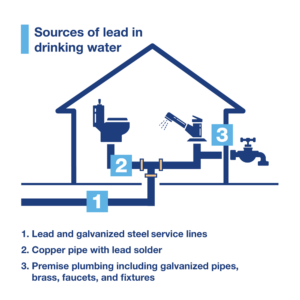Home / Minimize Your Risk
Minimize Your Risk
 Lead is a toxic metal that was used for decades in products found in and around our homes. Swallowing lead paint chips or breathing in lead paint dust presents the biggest risk for exposure. Lead can also get into drinking water through the corrosion of pipes that are made of lead or galvanized steel. While there has never been a documented case in Kentucky of lead poisoning linked to drinking water, utilities like Louisville Water must be focused on maintaining water quality and eliminating the risks for lead to get into drinking water: pipes and plumbing made of lead.
Lead is a toxic metal that was used for decades in products found in and around our homes. Swallowing lead paint chips or breathing in lead paint dust presents the biggest risk for exposure. Lead can also get into drinking water through the corrosion of pipes that are made of lead or galvanized steel. While there has never been a documented case in Kentucky of lead poisoning linked to drinking water, utilities like Louisville Water must be focused on maintaining water quality and eliminating the risks for lead to get into drinking water: pipes and plumbing made of lead.
Ingesting lead can cause health concerns for people of all ages, particularly pregnant women, infants, and young children. In children, low exposure levels are linked to learning disabilities, behavioral problems, and other issues. No amount of lead is safe.
Louisville Water has completed its service line inventory to find the locations of known lead service lines on customer properties and we have flagged the addresses where we don’t know the material of the line. Check our records here.
Maintain Optimal Water Quality
If you want to minimize potential exposure to lead in drinking water, follow these simple steps:
- Run cold water for a minimum of five minutes after water has been stagnant for more than six hours.
- Allow the cold water line to run for a minimum of five minutes before using the water for cooking or drinking. Only use cold water for cooking or preparing baby formula.
- Never use hot water for consumption.
- Consider purchasing a filter certified by NSF for lead reduction.
- Remove any faucet aerators, soak in vinegar for 15 minutes, and clean any accumulated particles. The aerator is at the tip of most faucets and can usually be screwed on and off.
- If work is performed on any lead or galvanized lines, we recommend a 60-minute high-velocity cold water flush from your bathtub. Learn more about flushing your water lines with our step-by-step process. After a lead service line replacement, Louisville Water will provide a pitcher filter and recommends you use that for six months after replacement. Discard three cycles of ice from automatic machines, clean aerators, and flush your lines daily for five minutes as instructed above.

